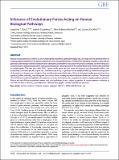Por favor, use este identificador para citar o enlazar a este item:
http://hdl.handle.net/10261/151820COMPARTIR / EXPORTAR:
 SHARE SHARE
 CORE
BASE CORE
BASE
|
|
| Visualizar otros formatos: MARC | Dublin Core | RDF | ORE | MODS | METS | DIDL | DATACITE | |

| Título: | Inference of Evolutionary Forces Acting on Human Biological Pathways |
Autor: | Daub, Josephine T. CSIC ORCID; Dupanloup, Isabelle; Robinson-Rechavi, Michael; Excoffier, Laurent | Palabras clave: | Human evolution Pathway analysis Polygenic selection McDonald–Kreitman test |
Fecha de publicación: | 13-may-2015 | Editor: | Oxford University Press | Citación: | Genome Biology and Evolution 7(6): 1546-1558 (2015) | Resumen: | Because natural selection is likely to act on multiple genes underlying a given phenotypic trait, we study here the potential effect of ongoing and past selection on the genetic diversity of human biological pathways. We first show that genes included in gene sets are generally under stronger selective constraints than other genes and that their evolutionary response is correlated. We then introduce a new procedure to detect selection at the pathway level based on a decomposition of the classical McDonald–Kreitman test extended to multiple genes. This new test, called 2DNS, detects outlier gene sets and takes into account past demographic effects and evolutionary constraints specific to gene sets. Selective forces acting on gene sets can be easily identified by a mere visual inspection of the position of the gene sets relative to their two-dimensional null distribution. We thus find several outlier gene sets that show signals of positive, balancing, or purifying selection but also others showing an ancient relaxation of selective constraints. The principle of the 2DNS test can also be applied to other genomic contrasts. For instance, the comparison of patterns of polymorphisms private to African and non-African populations reveals that most pathways show a higher proportion of nonsynonymous mutations in non-Africans than in Africans, potentially due to different demographic histories and selective pressures. | Versión del editor: | https://doi.org/10.1093/gbe/evv083 | URI: | http://hdl.handle.net/10261/151820 | DOI: | 10.1093/gbe/evv083 | ISSN: | 1759-6653 |
| Aparece en las colecciones: | (IBE) Artículos |
Ficheros en este ítem:
| Fichero | Descripción | Tamaño | Formato | |
|---|---|---|---|---|
| evv083.pdf | 3,69 MB | Adobe PDF |  Visualizar/Abrir |
CORE Recommender
PubMed Central
Citations
8
checked on 16-abr-2024
SCOPUSTM
Citations
10
checked on 18-abr-2024
WEB OF SCIENCETM
Citations
10
checked on 28-feb-2024
Page view(s)
289
checked on 18-abr-2024
Download(s)
222
checked on 18-abr-2024

